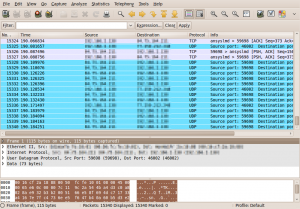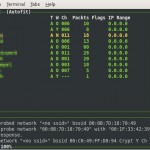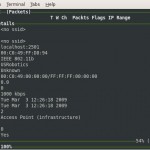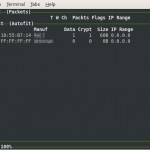Today I post something about the nice little tool fail2ban. As you probably know, fail2ban can be used to block those annoying brute force attacks against your servers. Other than the also popular and useful tool DenyHosts it allows the protection of other services than SSH as well (e.g. HTML login pages served by Apache). The working mechanism also differs from that of DenyHosts, as fail2ban uses iptables instead of the BSD style hosts.deny file to block annoying brute forcers. Installation is quite simple, on Debian for example, just install it through apt and you’re good to go even with the default config.
One thing that I was missing, was the option to ban IPs forever. You can basically do this by setting bantime to a negative value, but as soon as you reload your iptables rules (e.g. by restarting the fail2ban service or the whole system) the entries for the permanently banned IPs are gone.
To overcome this issue, I did some minor changes to the actions fail2ban executes on start-up and on banning.
IMPORTANT: I strongly advise you, to be careful while playing around with automated banning tools, especially if you can’t reach your server physically. Make sure, that you have something useful set in the ignoreip option under the [DEFAULT] jail (your current IP address) to not accidentally lock you out of the system (really nasty with permanent banning active…)
- First, check the banaction currently used (you need that, to modify the correct actionfile afterwards)
/etc/fail2ban/jail.local# # ACTIONS # ... banaction = iptables-multiport ... - Open up the corresponding actionfile and modify according to the sample below (changes are under the # Persistent banning of IPs comment)
/etc/fail2ban/action.d/iptables-multiport.conf... actionstart = iptables -N fail2ban-<name> iptables -A fail2ban-<name> -j RETURN iptables -I INPUT -p <protocol> -m multiport --dports <port> -j fail2ban-<name> # Persistent banning of IPs cat /etc/fail2ban/ip.blacklist | while read IP; do iptables -I fail2ban-<name> 1 -s $IP -j DROP; done ... actionban = iptables -I fail2ban-<name> 1 -s <ip> -j DROP # Persistent banning of IPs echo '<ip>' >> /etc/fail2ban/ip.blacklist ... - Your blacklist should look something like this (one IP per line, of course you can add IPs manually)
/etc/fail2ban/ip.blacklist... 10.0.0.242 192.168.1.39 ... - Restart fail2ban to make the changes active
Now, what happens is that each time fail2ban starts, it loops through your ip.blacklist and blocks the IPs in there. If fail2ban blocks a new IP, it will automatically append it to the blacklist.
Links
http://www.fail2ban.org
http://www.fail2ban.org/wiki/index.php/Whitelist
http://denyhosts.sourceforge.net
Update
The following config adds some nice features that were missing in the example above:
- No duplicate iptables rules (@Lin: might be interesting for you)
- Jail specific blocking rules (similar to Dr. Tyrell’s and samuelE’s suggestions in the comments)
- Reporting offender IPs to badips.com
/etc/fail2ban/action.d/iptables-multiport.conf:
# Fail2Ban configuration file
#
# Author: Cyril Jaquier
# Modified by Yaroslav Halchenko for multiport banning and Lukas Camenzind for persistent banning
#
#
[Definition]
# Option: actionstart
# Notes.: command executed once at the start of Fail2Ban.
# Values: CMD
#
actionstart = iptables -N fail2ban-<name>
iptables -A fail2ban-<name> -j RETURN
iptables -I INPUT -p <protocol> -m multiport --dports <port> -j fail2ban-<name>
# Load local list of offenders
if [ -f /etc/fail2ban/ip.blacklist ]; then cat /etc/fail2ban/ip.blacklist | grep -e <name>$ | cut -d "," -s -f 1 | while read IP; do iptables -I fail2ban-<name> 1 -s $IP -j DROP; done; fi
# Option: actionstop
# Notes.: command executed once at the end of Fail2Ban
# Values: CMD
#
actionstop = iptables -D INPUT -p <protocol> -m multiport --dports <port> -j fail2ban-<name>
iptables -F fail2ban-<name>
iptables -X fail2ban-<name>
# Option: actioncheck
# Notes.: command executed once before each actionban command
# Values: CMD
#
actioncheck = iptables -n -L INPUT | grep -q fail2ban-<name>
# Option: actionban
# Notes.: command executed when banning an IP. Take care that the
# command is executed with Fail2Ban user rights.
# Tags: <ip> IP address
# <failures> number of failures
# <time> unix timestamp of the ban time
# Values: CMD
#
actionban = if ! iptables -C fail2ban-<name> -s <ip> -j DROP; then iptables -I fail2ban-<name> 1 -s <ip> -j DROP; fi
# Add offenders to local blacklist, if not already there
if ! grep -Fxq '<ip>,<name>' /etc/fail2ban/ip.blacklist; then echo '<ip>,<name>' >> /etc/fail2ban/ip.blacklist; fi
# Report offenders to badips.com
wget -q -O /dev/null www.badips.com/add/<name>/<ip>
# Option: actionunban
# Notes.: command executed when unbanning an IP. Take care that the
# command is executed with Fail2Ban user rights.
# Tags: <ip> IP address
# <failures> number of failures
# <time> unix timestamp of the ban time
# Values: CMD
#
actionunban = iptables -D fail2ban-<name> -s <ip> -j DROP
# Disabled clearing out entry from ip.blacklist (somehow happens after each stop of fail2ban)
# sed --in-place '/<ip>,<name>/d' /etc/fail2ban/ip.blacklist
[Init]
# Defaut name of the chain
#
name = default
# Option: port
# Notes.: specifies port to monitor
# Values: [ NUM | STRING ] Default:
#
port = ssh
# Option: protocol
# Notes.: internally used by config reader for interpolations.
# Values: [ tcp | udp | icmp | all ] Default: tcp
#



